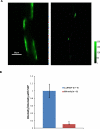Sphingosine-1-phosphate Maintains Normal Vascular Permeability by Preserving Endothelial Surface Glycocalyx in Intact Microvessels
- PMID: 27015105
- PMCID: PMC4866498
- DOI: 10.1111/micc.12278
Sphingosine-1-phosphate Maintains Normal Vascular Permeability by Preserving Endothelial Surface Glycocalyx in Intact Microvessels
Abstract
Objective: S1P was found to protect the ESG by inhibiting MMP activity-dependent shedding of ESG in cultured endothelial cell studies. We aimed to further test that S1P contributes to the maintenance of normal vascular permeability by protecting the ESG in intact microvessels.
Methods: We quantified the ESG in post-capillary venules of rat mesentery and measured the vascular permeability to albumin in the presence and absence of 1 μM S1P. We also measured permeability to albumin in the presence of MMP inhibitors and compared the measured permeability with those predicted by a transport model for the inter-endothelial cleft.
Results: We found that in the absence of S1P, the fluorescence intensity of the FITC-anti-HS-labeled ESG was ~10% of that in the presence of S1P, whereas the measured permeability to albumin was ~6.5-fold of that in the presence of S1P. Similar results were observed with MMP inhibition. The predictions by the mathematical model further confirmed that S1P maintains microvascular permeability by preserving ESG.
Conclusions: Our results show that S1P contributes to the maintenance of normal vascular permeability by protecting the ESG in intact microvessels, consistent with parallel observation in cultured endothelial monolayers.
Keywords: heparan sulfate; in situ immunostaining; matrix metalloproteinase; rat mesentery; transport model for the inter-endothelial cleft.
© 2016 John Wiley & Sons Ltd.
Figures






Similar articles
-
Sphingosine-1-phosphate reduces adhesion of malignant mammary tumor cells MDA-MB-231 to microvessel walls by protecting endothelial surface glycocalyx.Cell Mol Biol (Noisy-le-grand). 2017 Apr 29;63(4):16-22. doi: 10.14715/cmb/2017.63.4.3. Cell Mol Biol (Noisy-le-grand). 2017. PMID: 28478798
-
Sphingosine-1-phosphate prevents permeability increases via activation of endothelial sphingosine-1-phosphate receptor 1 in rat venules.Am J Physiol Heart Circ Physiol. 2010 Nov;299(5):H1494-504. doi: 10.1152/ajpheart.00462.2010. Epub 2010 Aug 20. Am J Physiol Heart Circ Physiol. 2010. PMID: 20729401 Free PMC article.
-
Adhesion of malignant mammary tumor cells MDA-MB-231 to microvessel wall increases microvascular permeability via degradation of endothelial surface glycocalyx.J Appl Physiol (1985). 2012 Oct;113(7):1141-53. doi: 10.1152/japplphysiol.00479.2012. Epub 2012 Aug 2. J Appl Physiol (1985). 2012. PMID: 22858626 Free PMC article.
-
Review: novel insights into the regulation of vascular tone by sphingosine 1-phosphate.Placenta. 2014 Feb;35 Suppl:S86-92. doi: 10.1016/j.placenta.2013.12.006. Epub 2013 Dec 21. Placenta. 2014. PMID: 24411702 Review.
-
In vitro and in vivo modulation of vascular barrier integrity by sphingosine 1-phosphate: mechanistic insights.Cell Signal. 2005 Feb;17(2):131-9. doi: 10.1016/j.cellsig.2004.08.006. Cell Signal. 2005. PMID: 15494205 Review.
Cited by
-
The Antithrombotic Function of Sphingosine-1-Phosphate on Human Adipose-Stem-Cell-Recellularized Tissue Engineered Vascular Graft In Vitro.Int J Mol Sci. 2019 Oct 21;20(20):5218. doi: 10.3390/ijms20205218. Int J Mol Sci. 2019. PMID: 31640220 Free PMC article.
-
Sphingosine 1-phosphate and its regulatory role in vascular endothelial cells.Histol Histopathol. 2022 Mar;37(3):213-225. doi: 10.14670/HH-18-428. Epub 2022 Feb 4. Histol Histopathol. 2022. PMID: 35118637 Review.
-
Dynamics of Vascular Protective and Immune Supportive Sphingosine-1-Phosphate During Cardiac Surgery.Front Immunol. 2021 Oct 20;12:761475. doi: 10.3389/fimmu.2021.761475. eCollection 2021. Front Immunol. 2021. PMID: 34745137 Free PMC article.
-
Endothelial glycocalyx as a critical signalling platform integrating the extracellular haemodynamic forces and chemical signalling.J Cell Mol Med. 2017 Aug;21(8):1457-1462. doi: 10.1111/jcmm.13081. Epub 2017 Feb 17. J Cell Mol Med. 2017. PMID: 28211170 Free PMC article. Review.
-
Plasma for prevention and treatment of glycocalyx degradation in trauma and sepsis.Crit Care. 2024 Jul 20;28(1):254. doi: 10.1186/s13054-024-05026-7. Crit Care. 2024. PMID: 39033135 Free PMC article. Review.
References
Publication types
MeSH terms
Substances
Grants and funding
LinkOut - more resources
Full Text Sources
Other Literature Sources

